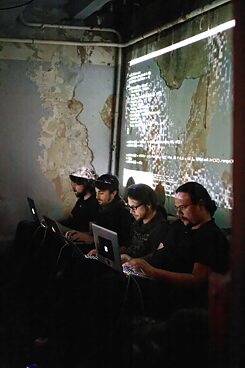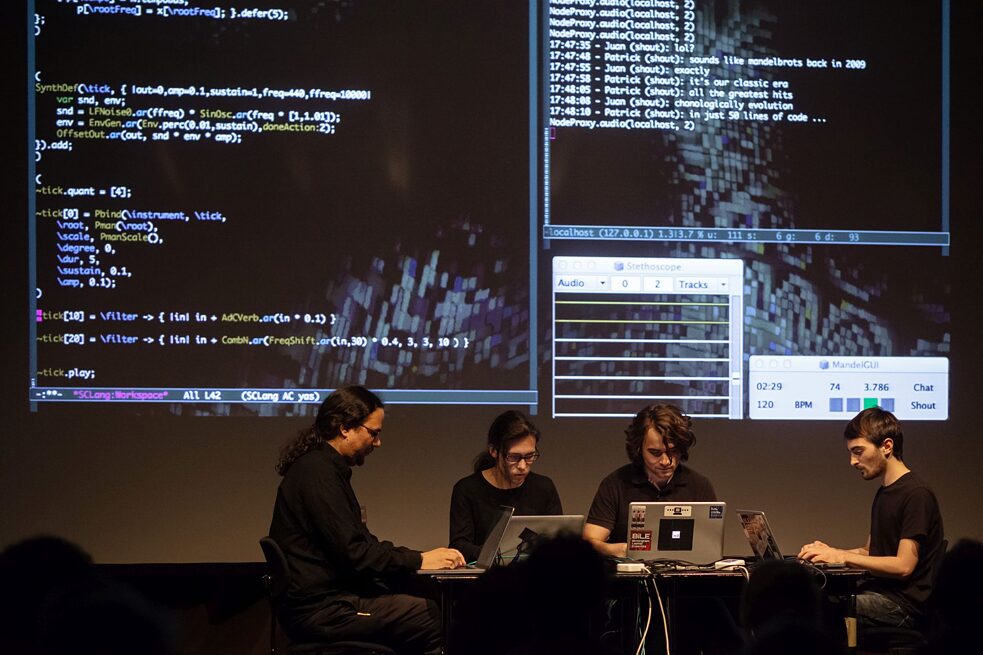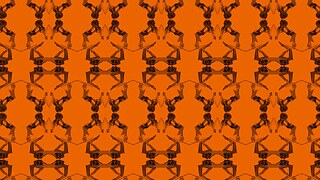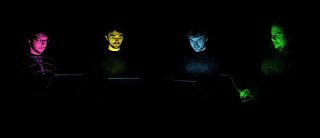“We all exchange roles”: How tech musicians Benoit and the Mandelbrots keep the rhythm
Live coding laptop band Benoît and the Mandelbrots produce a range of electronic music and regularly perform at so-called “algoraves.” The German-based tech-musicians spoke to the Goethe-Institut about how they go about their craft.
The relatively new term algorave is first credited to Alex McLean, a UK-based electronic musician who combined the words algorithm and rave way back in 2011. Since the first show in London, algoraves have become a global movement.
One of the German acts that regularly perform at algoraves is Benoît and the Mandelbrots. Named after the mathematician Benoit Mandelbrot, the Karlsruhe-based quartet perform live coding music shows in which the code is projected on the wall behind the stage.
Three of the band’s members – Patrick Borgeat, Juan A. Romeo and Matthias Schneiderbanger – spoke to Goethe-Institut about their music.
For people who haven’t yet heard of algoraves, please tell us what they are, how they work and what your involvement is.
Patrick Borgeat (PB): Algoraves are parties that celebrate algorithmic music with a strong focus on liveness and improvisation. A prevalent technique is live coding, where the performers are writing the algorithms that will shape the music and sometimes even the sounds themselves. It is common practice to also have algorithmically generated visuals alongside the music, and to project the coder’s screens so that the audience can not only enjoy a drink, listen to the music and have a dance but to also follow the process. With Benoît and the Mandelbrots we performed at several algoraves, and we also organised six algoraves here in Karlsruhe.
With algoraves happening all over the world now, do artists take varied approaches or is there a common denominator, like a go-to software such as SuperCollider or Alex McLean’s TidalCycles?
Juan A. Romero (JR): There are certainly some tendencies, but the environment is full of personalised setups and DIY languages. Generally, the idea is to express ourselves and make music, so some like to write it quick and concise, others prefer a slower approach but with more detail to the sounds and not the sequences. A lot of us started with SuperCollider or TidalCycles (which also uses SuperCollider in the background), but there has been a lot of development on the languages and also sampling or audio engines. Although it’s very easy to use SuperCollider as an “audio backend” for any other language you like, hence a lot of tools are combined with it.
In most bands, the musicians involved often play different instruments. With all four of you playing laptops, do you assign different creative roles to the four members?
We all have some kind of musical background, but this doesn’t affect our musical output. Two of us are more on the guitar side and the other two are more on the saxophone / wind instruments side. With our previous band Grainface, I played MIDI Guitar and Patrick played MIDI saxophone, but with the Mandelbrots, we all exchange roles, sometimes more bass lines or drums, sometimes just sound effects or harmonic sequences. It all depends on the day, how the music is being played and if someone thinks they have new ideas to throw in.
Your laptops are connected via a network which enables you to communicate, synchronise and share data. How does this work – can several people create and interfere with the music simultaneously?
In our setup everybody takes responsibility for their own sounds that they create and largely control themselves. The network, using a software component called BenoitLib, is mostly just there to synchronise our tempo and to allow us to send chat messages to each other. Through this network we can also share parameters, for example a harmonic sequence, so that we can play in tune with each other. A more important aspect of communication for us is the music itself, as one constantly listens carefully to find balance in all the sounds and to think of ways to progress the musical performance. This also includes nodding at each other or sometimes also less encouraging gestures when things are not right, always paired with a smile and a laugh though.
 Benoit in action
| © Steve Welburn
The question of authorship is often discussed in AI art. The algorave website states that musicians take responsibility for the music they make, rather than ‘pretending their software is being creative’. Where do you see yourselves in the argument?
Benoit in action
| © Steve Welburn
The question of authorship is often discussed in AI art. The algorave website states that musicians take responsibility for the music they make, rather than ‘pretending their software is being creative’. Where do you see yourselves in the argument?
JR: I see myself in the creative role. The music and the code I make has some, let’s call it, “controlled randomness” but I wouldn’t say it plays itself or it evolves over time. I am the one evolving the algorithm, playing it on time, executing it when I think the music needs some changes or additions – but in the end, these are all personal choices and I do them as I please.
Your music is clearly recognisable as electronic music in the sense that it uses virtual instruments, repetition, synth lines, beats, soundscapes and so on. Do you have a sonic outcome in mind when you start and therefore set certain parameters within which you improvise and operate?
Matthias Schneiderbanger (MS): Generally, we want to feel the present, the ambience, the mood of the audience and take these vibes as our main inspiration for what comes next. But over the years we unintentionally developed some kind of meta language that helps us describe certain moods we want to achieve. It consists of terms like “noisy”, “beaty” or “ambienty” and describes certain perceptions that evolved during past performances and reliably help us to start with when we encounter a new concert situation. These terms don’t explicitly define parameters, but at the same time every one of us has his own techniques to address these keywords. Our common experience is maybe the main reason why we’re able to communicate with very few terms. The rest of the communication happens through music. Benoit and the Mandelbrots perform at the live.code.festival 2013 in Karlsruhe
| © Daniel Bollinger
Karlsruhe is a medium-sized city with many universities, some of which specialise in the arts and music, as well as the internationally renowned ZKM (Centre for Art and Media). Tell us about the local art and music scene there and the connections between institutions and genres.
Benoit and the Mandelbrots perform at the live.code.festival 2013 in Karlsruhe
| © Daniel Bollinger
Karlsruhe is a medium-sized city with many universities, some of which specialise in the arts and music, as well as the internationally renowned ZKM (Centre for Art and Media). Tell us about the local art and music scene there and the connections between institutions and genres.
PB: Key to the formation of our band and our involvement with the live coding scene in general is the course of Music Informatics and Musicology (IMWI) at the University of Music in Karlsruhe where we all met. We first got in touch with live coding in guest lectures of Alberto de Campo and Julian Rohrhuber, two live coding pioneers. At IMWI we were able to organise the live.code.festival in 2013, which was one of the early global gatherings of the live coding scene.
For a series of algoraves, with many international artists from abroad, we found a very enthusiastic partner in Jubez, a culture and youth centre in Karlsruhe, which offers a varied programme of concerts, lectures and other events. And finally, we also had the pleasure to perform at or collaborate with ZKM many times. Nowadays we’re not truly based in Karlsruhe anymore as Juan moved to Frankfurt and Holger moved to Newcastle in the UK. He also lived in Australia for some time.
Finally, what triggered you to choose a band name based on Benoit Mandelbrot? Did he have specific ideas that you find adaptable for your creative process?
MS: I guess every one of us has a different relation to our band name, but as for me, I always think back to courses in algorithmic composition with Professor Denis Lorrain, where he introduced us amongst other things to algorithms based on Benoît Mandelbrot’s fractals and their musical adaptation. We never used fractal algorithms in our music, but at the same time we followed the lead to create complex structures from simple algorithms. In addition, we had this idea of forming a typical band despite our atypical live-coding approach. Hence, we were looking for a name that would transport this idea and resemble other typical group names like Huey Lewis and the News or Kool and the Gang. And maybe we also wanted to distance ourselves from the mainly academical and contemporary music environment where live-coding originally emerged.
Benoît and the Mandelbrots is a band made up of Patrick Borgeat, Juan A. Romero, Matthias Schneiderbanger and Holger Ballweg. Formed in 2009 in Karlsruhe, Germany, the band is known for live coding and algorave performances.
One of the German acts that regularly perform at algoraves is Benoît and the Mandelbrots. Named after the mathematician Benoit Mandelbrot, the Karlsruhe-based quartet perform live coding music shows in which the code is projected on the wall behind the stage.
Three of the band’s members – Patrick Borgeat, Juan A. Romeo and Matthias Schneiderbanger – spoke to Goethe-Institut about their music.
For people who haven’t yet heard of algoraves, please tell us what they are, how they work and what your involvement is.
Patrick Borgeat (PB): Algoraves are parties that celebrate algorithmic music with a strong focus on liveness and improvisation. A prevalent technique is live coding, where the performers are writing the algorithms that will shape the music and sometimes even the sounds themselves. It is common practice to also have algorithmically generated visuals alongside the music, and to project the coder’s screens so that the audience can not only enjoy a drink, listen to the music and have a dance but to also follow the process. With Benoît and the Mandelbrots we performed at several algoraves, and we also organised six algoraves here in Karlsruhe.
With algoraves happening all over the world now, do artists take varied approaches or is there a common denominator, like a go-to software such as SuperCollider or Alex McLean’s TidalCycles?
Juan A. Romero (JR): There are certainly some tendencies, but the environment is full of personalised setups and DIY languages. Generally, the idea is to express ourselves and make music, so some like to write it quick and concise, others prefer a slower approach but with more detail to the sounds and not the sequences. A lot of us started with SuperCollider or TidalCycles (which also uses SuperCollider in the background), but there has been a lot of development on the languages and also sampling or audio engines. Although it’s very easy to use SuperCollider as an “audio backend” for any other language you like, hence a lot of tools are combined with it.
In most bands, the musicians involved often play different instruments. With all four of you playing laptops, do you assign different creative roles to the four members?
We all have some kind of musical background, but this doesn’t affect our musical output. Two of us are more on the guitar side and the other two are more on the saxophone / wind instruments side. With our previous band Grainface, I played MIDI Guitar and Patrick played MIDI saxophone, but with the Mandelbrots, we all exchange roles, sometimes more bass lines or drums, sometimes just sound effects or harmonic sequences. It all depends on the day, how the music is being played and if someone thinks they have new ideas to throw in.
Your laptops are connected via a network which enables you to communicate, synchronise and share data. How does this work – can several people create and interfere with the music simultaneously?
In our setup everybody takes responsibility for their own sounds that they create and largely control themselves. The network, using a software component called BenoitLib, is mostly just there to synchronise our tempo and to allow us to send chat messages to each other. Through this network we can also share parameters, for example a harmonic sequence, so that we can play in tune with each other. A more important aspect of communication for us is the music itself, as one constantly listens carefully to find balance in all the sounds and to think of ways to progress the musical performance. This also includes nodding at each other or sometimes also less encouraging gestures when things are not right, always paired with a smile and a laugh though.
 Benoit in action
| © Steve Welburn
The question of authorship is often discussed in AI art. The algorave website states that musicians take responsibility for the music they make, rather than ‘pretending their software is being creative’. Where do you see yourselves in the argument?
Benoit in action
| © Steve Welburn
The question of authorship is often discussed in AI art. The algorave website states that musicians take responsibility for the music they make, rather than ‘pretending their software is being creative’. Where do you see yourselves in the argument?JR: I see myself in the creative role. The music and the code I make has some, let’s call it, “controlled randomness” but I wouldn’t say it plays itself or it evolves over time. I am the one evolving the algorithm, playing it on time, executing it when I think the music needs some changes or additions – but in the end, these are all personal choices and I do them as I please.
Your music is clearly recognisable as electronic music in the sense that it uses virtual instruments, repetition, synth lines, beats, soundscapes and so on. Do you have a sonic outcome in mind when you start and therefore set certain parameters within which you improvise and operate?
Matthias Schneiderbanger (MS): Generally, we want to feel the present, the ambience, the mood of the audience and take these vibes as our main inspiration for what comes next. But over the years we unintentionally developed some kind of meta language that helps us describe certain moods we want to achieve. It consists of terms like “noisy”, “beaty” or “ambienty” and describes certain perceptions that evolved during past performances and reliably help us to start with when we encounter a new concert situation. These terms don’t explicitly define parameters, but at the same time every one of us has his own techniques to address these keywords. Our common experience is maybe the main reason why we’re able to communicate with very few terms. The rest of the communication happens through music.
 Benoit and the Mandelbrots perform at the live.code.festival 2013 in Karlsruhe
| © Daniel Bollinger
Karlsruhe is a medium-sized city with many universities, some of which specialise in the arts and music, as well as the internationally renowned ZKM (Centre for Art and Media). Tell us about the local art and music scene there and the connections between institutions and genres.
Benoit and the Mandelbrots perform at the live.code.festival 2013 in Karlsruhe
| © Daniel Bollinger
Karlsruhe is a medium-sized city with many universities, some of which specialise in the arts and music, as well as the internationally renowned ZKM (Centre for Art and Media). Tell us about the local art and music scene there and the connections between institutions and genres.PB: Key to the formation of our band and our involvement with the live coding scene in general is the course of Music Informatics and Musicology (IMWI) at the University of Music in Karlsruhe where we all met. We first got in touch with live coding in guest lectures of Alberto de Campo and Julian Rohrhuber, two live coding pioneers. At IMWI we were able to organise the live.code.festival in 2013, which was one of the early global gatherings of the live coding scene.
For a series of algoraves, with many international artists from abroad, we found a very enthusiastic partner in Jubez, a culture and youth centre in Karlsruhe, which offers a varied programme of concerts, lectures and other events. And finally, we also had the pleasure to perform at or collaborate with ZKM many times. Nowadays we’re not truly based in Karlsruhe anymore as Juan moved to Frankfurt and Holger moved to Newcastle in the UK. He also lived in Australia for some time.
Finally, what triggered you to choose a band name based on Benoit Mandelbrot? Did he have specific ideas that you find adaptable for your creative process?
MS: I guess every one of us has a different relation to our band name, but as for me, I always think back to courses in algorithmic composition with Professor Denis Lorrain, where he introduced us amongst other things to algorithms based on Benoît Mandelbrot’s fractals and their musical adaptation. We never used fractal algorithms in our music, but at the same time we followed the lead to create complex structures from simple algorithms. In addition, we had this idea of forming a typical band despite our atypical live-coding approach. Hence, we were looking for a name that would transport this idea and resemble other typical group names like Huey Lewis and the News or Kool and the Gang. And maybe we also wanted to distance ourselves from the mainly academical and contemporary music environment where live-coding originally emerged.
Benoît and the Mandelbrots is a band made up of Patrick Borgeat, Juan A. Romero, Matthias Schneiderbanger and Holger Ballweg. Formed in 2009 in Karlsruhe, Germany, the band is known for live coding and algorave performances.

